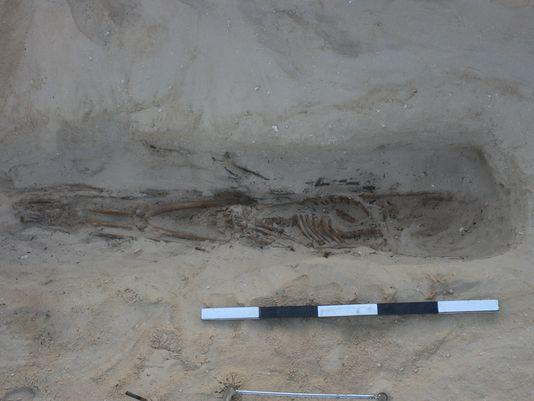Traci Watson
Source - http://www.usatoday.com/story/news/2015/10/13/egypt-cemetery-punishment-lashes-wounds/73688038/
 (Photo: Image courtesy of the Amarna Trust)
(Photo: Image courtesy of the Amarna Trust)
An ancient wall carving spells out the bloody punishment for stealing animal hides: 100 lashes and five wounds. Egyptologists have long wondered whether that was a literal description.
Now skeletons showing evidence of that sentence have been found in a humble cemetery in the ancient Egyptian capital of Amarna.
Five middle-aged men buried in Amarna's cemetery for commoners seem to have been stabbed in the shoulder blade by a spear, scientists report in the International Journalof Paleopathology.
The misdeeds and names of the five men are unknown. But the researchers do know that many people with such injuries can quickly get back go work – a benefit to bosses in a city employing legions of laborers in stone-finishing workshops and quarries.
The lives of the everyday folk at Amarna "were filled with hardships that included heavy labor and often dietary insufficiency," study author Gretchen Dabbs of Southern Illinois University says via email from Amarna, where she's examining more skeletons. "We know that life in this place was physically taxing. This is another example of that."
It took especially taxing toil to build Amarna, a desert capital constructed some 3,300 years ago and dedicated to the sun god Aten. A grand city of stone palaces and temples, Amarna rose hurriedly from the desert at the command of the "Heretic King"Akhenaten.
Those put to rest in the commoners' cemetery suffered from high rates of joint disease, potentially caused by carrying heavy loads. Many bear signs of scurvy and other conditions linked to malnutrition.
Starting just under a decade ago, Dabbs and her colleagues noticed that some of the bodies had a mysterious slot-shaped gash in the bone of the shoulder blade. The gashes had been inflicted from an assailant standing behind the victim, making them unlikely to be battle wounds. Accidental falls couldn't explain the injuries either.
But the gashes turned out to be a good fit for a punishment described in the ancient texts. One ancient Egyptian fable tells of a thief who steals an ox and is punished with 100 blows and five wounds. A royal decree describes a similar fate for officials who commandeer workers for a construction project, and ancient Egyptian tax dodgers were beaten while lying facedown on the ground, just as those in the Amarna cemetery were stabbed from behind.
 Depiction of punishment in ancient Egypt (akhepedia.com).
Depiction of punishment in ancient Egypt (akhepedia.com).
The researchers make "a pretty solid case here," says bioarchaeologist Brenda Baker of Arizona State University, who has also worked on ancient Egyptian skeletons. She says the study's explanation makes sense. The ancient Egyptians "didn't have jails the way we do today, so public lashing of this sort was probably prescribed."
Even more brutal punishments were handed out to some wrongdoers in ancient Egypt, says historian Joseph Manning of Yale University. Tomb robbers were put to death, and those accused of "high state crimes" such as tax evasion might have their ears or noses lopped off. But such harsh justice is "a little bit unusual," he says. He'd like to see more evidence from other sites to be sure that this treatment wasn't unique to Amarna.
Dabbs responds that there's a chance that this regimen was applied only in Amarna, but plenty of texts from outside the city describe corporal punishment. She hopes other researchers will go back to their skeleton collections and examine the shoulder blades – bones that are often overlooked -- for evidence of the backstabbing punishment carried out in the city of the sun.